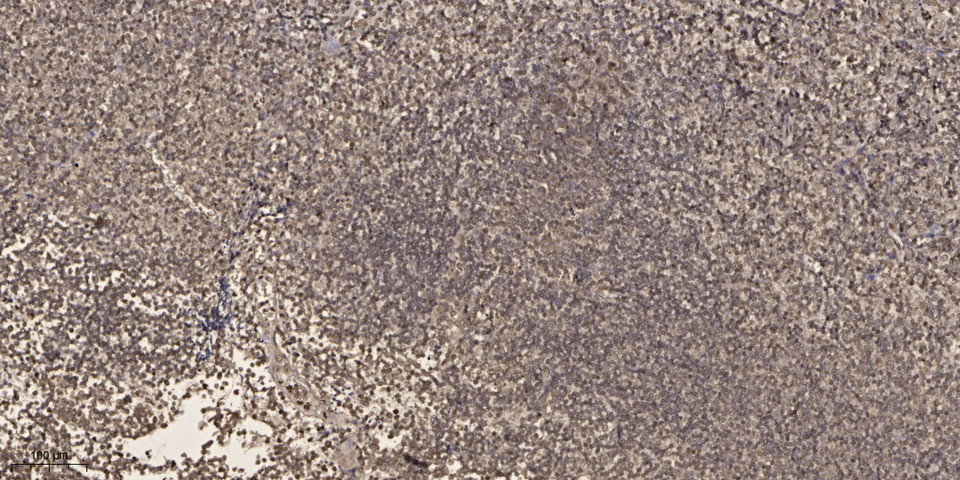SP-100 Polyclonal Antibody
- Catalog No.:YT4374
- Applications:WB;IHC;IF;ELISA
- Reactivity:Human;Mouse
- Target:
- SP-100
- Fields:
- >>Herpes simplex virus 1 infection;>>Viral carcinogenesis
- Gene Name:
- SP100
- Protein Name:
- Nuclear autoantigen Sp-100
- Human Gene Id:
- 6672
- Human Swiss Prot No:
- P23497
- Mouse Swiss Prot No:
- O35892
- Immunogen:
- Synthesized peptide derived from SP-100 . at AA range: 250-330
- Specificity:
- SP-100 Polyclonal Antibody detects endogenous levels of SP-100 protein.
- Formulation:
- Liquid in PBS containing 50% glycerol, 0.5% BSA and 0.02% sodium azide.
- Source:
- Polyclonal, Rabbit,IgG
- Dilution:
- WB 1:500 - 1:2000. IHC 1:100 - 1:300. ELISA: 1:40000.. IF 1:50-200
- Purification:
- The antibody was affinity-purified from rabbit antiserum by affinity-chromatography using epitope-specific immunogen.
- Concentration:
- 1 mg/ml
- Storage Stability:
- -15°C to -25°C/1 year(Do not lower than -25°C)
- Other Name:
- SP100;Nuclear autoantigen Sp-100;Lysp100b;Nuclear dot-associated Sp100 protein;Speckled 100 kDa
- Observed Band(KD):
- 100kD
- Background:
- This gene encodes a subnuclear organelle and major component of the PML (promyelocytic leukemia)-SP100 nuclear bodies. PML and SP100 are covalently modified by the SUMO-1 modifier, which is considered crucial to nuclear body interactions. The encoded protein binds heterochromatin proteins and is thought to play a role in tumorigenesis, immunity, and gene regulation. Alternatively spliced variants have been identified for this gene; one of which encodes a high-mobility group protein. [provided by RefSeq, Aug 2011],
- Function:
- disease:This antigen is recognized by autoantibodies from patients with primary biliary cirrhosis (PBC).,domain:Contains one Pro-Xaa-Val-Xaa-Leu (PxVxL) motif, which is required for interaction with chromoshadow domains. This motif requires additional residues -7, -6, +4 and +5 of the central Val which contact the chromoshadow domain.,domain:The HSR domain is important for the nuclear body targeting as well as for the dimerization.,function:May play a role in the control of gene expression.,induction:By interferon.,miscellaneous:The major isoform Sp100-A, has a calculated MW of 54 kDa, but exhibits aberrant electrophoretic mobilities, with an apparent MW OF 100 kDa.,PTM:Phosphorylated.,PTM:Sumoylated. Sumoylation depends on a functional nuclear localization signal but is not necessary for nuclear import or nuclear body targeting.,similarity:Contains 1 HSR domain.,similarity:Contains 1 SA
- Subcellular Location:
- Nucleus. Nucleus, PML body . Cytoplasm. Differences in the subnuclear localization of the different isoforms seem to exist and may also be cell cycle- and interferon-dependent. Accumulates in the cytoplasm upon FAS activation.; [Isoform Sp100-C]: Nucleus . Forms a reticulate or track-like nuclear pattern with denser concentrations at the nuclear lamina and surrounding the nucleoli, a pattern reminiscent of heterochromatin-rich regions according to PubMed:11313457.
- Expression:
- Widely expressed. Sp100-B is expressed only in spleen, tonsil, thymus, mature B-cell line and some T-cell line, but not in brain, liver, muscle or non-lymphoid cell lines.
- June 19-2018
- WESTERN IMMUNOBLOTTING PROTOCOL
- June 19-2018
- IMMUNOHISTOCHEMISTRY-PARAFFIN PROTOCOL
- June 19-2018
- IMMUNOFLUORESCENCE PROTOCOL
- September 08-2020
- FLOW-CYTOMEYRT-PROTOCOL
- May 20-2022
- Cell-Based ELISA│解您多样本WB检测之困扰
- July 13-2018
- CELL-BASED-ELISA-PROTOCOL-FOR-ACETYL-PROTEIN
- July 13-2018
- CELL-BASED-ELISA-PROTOCOL-FOR-PHOSPHO-PROTEIN
- July 13-2018
- Antibody-FAQs
- Products Images

- Immunohistochemical analysis of paraffin-embedded human tonsil. 1, Antibody was diluted at 1:200(4° overnight). 2, Tris-EDTA,pH9.0 was used for antigen retrieval. 3,Secondary antibody was diluted at 1:200(room temperature, 45min).



